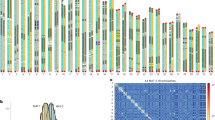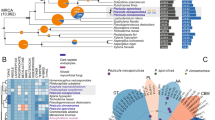Abstract
Pawlowska and Taylor reply - To challenge the hypothesis of multigenomic structure of arbuscular mycorrhizal (AM) fungi1,2, we presented three lines of evidence consistent with the homokaryotic organization of within-individual genetic variation, including distribution of polymorphic genetic markers among and within field isolates of an AM fungus, and distribution of ribosomal DNA variants among individually microdissected nuclei3. Bever and Wang suggest4 that our data can be explained equally well by heterokaryosis, proposing a model that relies on the assumption that fusions of hyphae of genetically non-identical individuals contribute to the creation and maintenance of a multigenomic status of AM fungal cells. However, we do not believe that this assumption is supported by existing biological evidence.
Similar content being viewed by others
Main
To support their idea of hyphal fusion in AM fungi, Bever and Wang cite studies5,6 that present data on successful fusions among hyphae only within an individual mycelium and among mycelia derived from spores representing the same isolate — the studies contain no results that support fusions of genetically different individuals. But Bever and Wang's formula for heterokaryon formation and maintenance requires fusions of hyphae among genetically distinct mycelia. Several studies7,8 of self versus non-self recognition in fungi have revealed sophisticated mechanisms that prevent fusion of genetically differentiated individuals unless the partners are in the sexual mode, which has never been observed in Glomerales.
In the vegetative mode, genetic compatibility at several loci is required for a successful fusion, which effectively limits fusions of hyphae to those within an individual mycelium or among genetically identical mycelia derived from the same isolate7,8. Encounters among non-identical vegetative mycelia initiate a battery of antagonistic responses. Such vegetative incompatibility responses have also been reported in AM fungi during encounters between genetically differentiated isolates of Glomus mosseae9, indicating that AM fungi have self-recognition mechanisms that are equally sophisticated and operate like those in other fungi. In our simulation model of heterokaryosis3, we therefore explicitly excluded the possibility that vegetative hyphal fusions among genetically differentiated individuals could contribute to the creation and maintenance of multigenomic individuals of AM fungi.
Bever and Wang contest our evidence of the containment of the entire intrasporal rDNA variation in each individually microdissected nucleus, which they claim is not definitive as the nuclei could still vary in the number of copies of each of the rDNA types. However, the quantitative issue of copy number is not relevant to a qualitative distinction between heterokaryosis and homokaryosis. The nucleolar organizer regions, which harbour tandemly repeated rRNA gene copies, are dynamic, and the number of rRNA genes may change even during the lifespan of a single cell10. The model of heterokaryosis proposed for AM fungi2, which we tested by using data from microdissection, made no claims about the number of copies of different rDNA types, but stipulated that different rDNA sequences should be distributed among different nuclei within an individual; we found no evidence to support this idea.
On the basis of our results3 and of reports of exceptionally large genome sizes in AM fungi11,12, we speculated that these fungi may have duplicated or polyploid genomes. A recent, considerably smaller genome-size estimate in G. intraradices indicates that the sizes of glomeromycotan genomes may not differ markedly from those in other fungi13. Bever and Wang cite this estimate as support for heterokaryosis in AM fungi. However, even very small fungal genomes contain arrays of duplicated genes, including rRNA-coding and protein-coding genes14. Thus, the evidence of small haploid genomes in AM fungi does not invalidate our conclusion that the intracellular genetic variation observed in these fungi is contained in each of the hundreds of nuclei that populate their cells and spores.
References
Bever, J. D. & Morton, J. B. Am. J. Bot. 86, 1209–1216 (1999).
Kuhn, G., Hijri, M. & Sanders, I. R. Nature 414, 745–748 (2001).
Pawlowska, T. E. & Taylor, J. W. Nature 427, 733–737 (2004).
Bever, J. D. & Wang, M. Nature doi:10.1038/nature03294 (2005).
Giovannetti, M., Azzolini, D. & Citernesi, A. S. Appl. Environ. Microbiol. 65, 5571–5575 (1999).
Giovannetti, M., Fortuna, P., Citernesi, A. S., Morini, S. & Nuti, M. P. New Phytol. 151, 717–724 (2001).
Glass, N. L. & Kaneko, I. Eukaryot. Cell 2, 1–8 (2003).
Worrall, J. J. Mycologia 89, 24–36 (1997).
Giovannetti, M. et al. Environ. Microbiol. 69, 616–624 (2003).
Sinclair, D. A. & Guarente, L. Cell 91, 1033–1042 (1997).
Bianciotto, V. & Bonfante, P. Mycol. Res. 96, 1071–1076 (1992).
Hosny, M., Gianinazzi-Pearson, V. & Dulieu, H. Genome 41, 422–428 (1998).
Hijri, M. & Sanders, I. R. Fungal Genet. Biol. 41, 253–261 (2004).
Dujon, B. et al. Nature 430, 35–44 (2004).
Author information
Authors and Affiliations
Corresponding author
Rights and permissions
About this article
Cite this article
Pawlowska, T., Taylor, J. Hyphal fusion and multigenomic structure (reply). Nature 433, E4 (2005). https://doi.org/10.1038/nature03295
Published:
Issue Date:
DOI: https://doi.org/10.1038/nature03295
This article is cited by
Comments
By submitting a comment you agree to abide by our Terms and Community Guidelines. If you find something abusive or that does not comply with our terms or guidelines please flag it as inappropriate.



